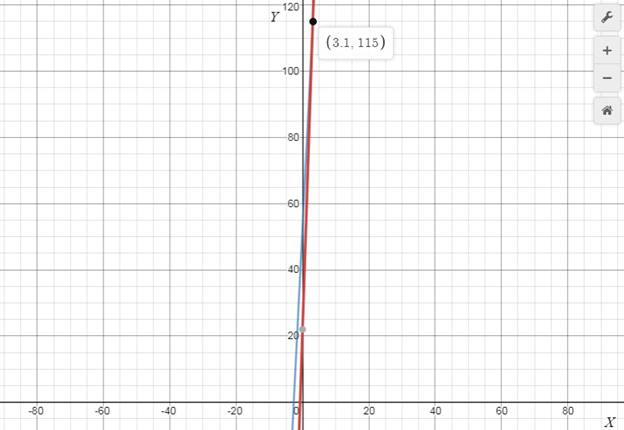
a.
Calculate the equation for the number of tickets each person has sold.
a.
Answer to Problem 25PPS
The two equation are y=20x+53 and y=30x+22 .
Explanation of Solution
Given:
It is given in the question that The person A sold 22 and then sold 30 per day after that, Jen sold 53 on Monday and then sold 20 per day after that .
Concept Used:
In this, use the concept of linear equations by understanding the correct variable and constant .
Calculation: Let y represents the number of tickets sold.
Let x represents the number of days.
Now, the equation for the the person Ais : y=30x+22
And the equation for the Jen is : y=20x+53
Conclusion:
The two equation are y=20x+53 and y=30x+22 .
b.
Draw the graph of the equation.
b.
Explanation of Solution
Given:
It is given in the question that the given two equation are, y=20x+53 and y=30x+22 .
Graph:

Interpretation: Here, put the both equation y=20x+53 and y=30x+22 in the graphing calculator, it gives the required graph.
In the above graph, it can be easily seen that the two graph intersect at (3.1,115) .
c.
Find the solution of the two equations. Check it.
c.
Answer to Problem 25PPS
The person A will have sold 3 more tickets.
Explanation of Solution
Given:
It is given in the question that the two graph gives the solution is (3.1,115) .
Concept Used:
In this, use the concept of linear equations by understanding the correct variable and constant .
Calculation: Here, the solution is (3.1,115) .To check the answer enter it into the both equation.
y=20x+53 115=20(3.1)+53115=62+53115=115
So, it is a solution for the first equation.Now check the second equation.
y=30x+22115=30(3.1)+22115=93+22115=115
So, it is a solution for the second equation.
Hence, After about 3 days, The person A will have sold more tickets.
Conclusion:
The person A will have sold 3 more tickets.
Chapter 6 Solutions
Algebra 1
Additional Math Textbook Solutions
Elementary Statistics: Picturing the World (7th Edition)
University Calculus: Early Transcendentals (4th Edition)
Elementary Statistics (13th Edition)
Basic Business Statistics, Student Value Edition
Calculus: Early Transcendentals (2nd Edition)
- 8) Solve the given system using the Gaussian Elimination process. 2x8y = 3 (-6x+24y = −6arrow_forward7) Solve the given system using the Gaussian Elimination process. (5x-4y = 34 (2x - 2y = 14arrow_forward33 (a) (b) Let A(t) = = et 0 0 0 cos(t) sin(t) 0-sin(t) cos(t)) For any fixed tЄR, find det(A(t)). Show that the matrix A(t) is invertible for any tЄ R, and find the inverse (A(t))¹.arrow_forward
- Use the infinite geometric sum to convert .258 (the 58 is recurring, so there is a bar over it) to a ratio of two integers. Please go over the full problem, specifying how you found r. Thank you.arrow_forwardH.w: Find the Eigen vectors for the largest Eigen value of the system X1+ +2x3=0 3x1-2x2+x3=0 4x1+ +3x3=0arrow_forwardneed help with 5 and 6 pleasearrow_forward
- 1) Given matrix A below, answer the following questions: a) What is the order of the matrix? b) What is the element a13? c) What is the element a₁₁? 4 -1arrow_forward[25 points] Given the vector let v = ER² and the collection of vectors ε = E-{)·()}-{☹) (9)} = {(A)·(9)}· B: = and C = · {(6)·(})}· answer the following question. (a) (b) (c) (d) (e) verify Verify is a basis for R² and find the coordinate [] of under ε. Verify B is a basis for R2 and find the coordinate []B of ʊ Verify C is a basis for R2 and find the coordinate []c of under ε. under ε. Find the change-of-basis matrix [I]+B from basis B to basis ε, and EE+BUB Find the change-of-basis matrix [I]B+ε from basis Ɛ to basis B, and verify [U]B= [] B+EVEarrow_forwardExplain the following terms | (a) linear span (b) dimension of vector space (c) linearly independent (d) linearly dependent (e) rank of matrix Aarrow_forward
- 3. Let u = 3/5 √ = and = -4/5 -() Define V span{ū, }. (a) (b) (c) Show that {u, } is orthonormal and forms a basis for V. Explicitly compute Projy w. Explicitly give a non-zero vector in V+.arrow_forwardIs 1.1 0.65 -3.4 0.23 0.4 -0.44 a basis for R3? You must explain your answer 0arrow_forwardFind the values of x and y in the following scalar multiplication. 8 2 x 1 3 || y = 9 LY_ Show Calculatorarrow_forward
 Algebra and Trigonometry (6th Edition)AlgebraISBN:9780134463216Author:Robert F. BlitzerPublisher:PEARSON
Algebra and Trigonometry (6th Edition)AlgebraISBN:9780134463216Author:Robert F. BlitzerPublisher:PEARSON Contemporary Abstract AlgebraAlgebraISBN:9781305657960Author:Joseph GallianPublisher:Cengage Learning
Contemporary Abstract AlgebraAlgebraISBN:9781305657960Author:Joseph GallianPublisher:Cengage Learning Linear Algebra: A Modern IntroductionAlgebraISBN:9781285463247Author:David PoolePublisher:Cengage Learning
Linear Algebra: A Modern IntroductionAlgebraISBN:9781285463247Author:David PoolePublisher:Cengage Learning Algebra And Trigonometry (11th Edition)AlgebraISBN:9780135163078Author:Michael SullivanPublisher:PEARSON
Algebra And Trigonometry (11th Edition)AlgebraISBN:9780135163078Author:Michael SullivanPublisher:PEARSON Introduction to Linear Algebra, Fifth EditionAlgebraISBN:9780980232776Author:Gilbert StrangPublisher:Wellesley-Cambridge Press
Introduction to Linear Algebra, Fifth EditionAlgebraISBN:9780980232776Author:Gilbert StrangPublisher:Wellesley-Cambridge Press College Algebra (Collegiate Math)AlgebraISBN:9780077836344Author:Julie Miller, Donna GerkenPublisher:McGraw-Hill Education
College Algebra (Collegiate Math)AlgebraISBN:9780077836344Author:Julie Miller, Donna GerkenPublisher:McGraw-Hill Education





